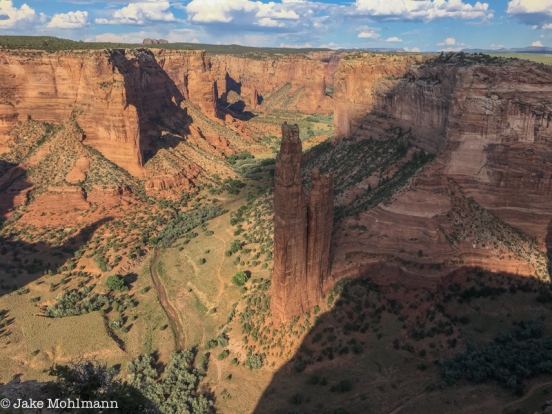
A late afternoon view up Canyon de Chelly. Photo: Jake Mohlmann
Our tour will combine breathtaking landscapes with exciting birdwatching, especially in the desert oases. We’ll visit world-renown canyons and monoliths sculpted from the massive Colorado Plateau, including the Grand Canyon, Bryce and Zion Canyons, Monument Valley, and the Petrified Forest. We’ll also stop at a number of historic and scenic sites in Navajo country before relaxing in the boreal coolness of eastern Arizona’s White Mountains.
Day 1: The trip begins at 6:00 pm in Phoenix. Night in Phoenix.
This was an excellent tour, the perfect mix of sightseeing and bird watching. It was the fastest 12 days I’ve ever spent. It was as well my third tour with Jake and he was, as always,sensitive to everyone’s abilities, capabilities and desires.
Kristi Shaw Sept 2018
Day 2: We’ll start this morning with a drive to Boyce Thompson Arboretum State Park east of Phoenix. Here we can expect an assortment of desert residents such as Black Phoebe, Cactus Wren, Phainopepla, Broad-billed Hummingbird, and Abert’s Towhee. Western migrants that commonly pass through the Arizona lowlands include Lazuli Bunting, Brewer’s Sparrow, MacGillivray’s Warbler, and Western Tanager. After lunch we’ll drive north, along the west side of Roosevelt Lake leaving the blazing heat behind as we climb the Mogollon Rim toward Flagstaff. Time permitting; we’ll stop at several lakes en route where we may see an assortment of ducks, Western Bluebird, American Kestrel, and possibly a herd of Elk chest deep in one of Arizona’s largest natural lakes. Night in Flagstaff.
Day 3: We’ll leave early for our drive to the North Rim of the Grand Canyon. Just after first light we’ll visit a local Flagstaff canyon where resident Lewis’s Woodpeckers feed on acorns overhead and more than 150 petroglyphs from the ancient dwellers who once lived here decorate the canyon walls. Our journey will take us through the spectacular Painted Desert and along the Vermilion Cliffs, where we’ll look for the recently reintroduced California Condor. We’ll arrive at the North Rim in the mid-afternoon in time to explore magnificent vantage points while birding in the ponderosa pine and spruce-fir forests that dominate the area. Steller’s Jay and Pygmy Nuthatch will be much in evidence and lingering summer residents may include Grace’s Warbler and Zone-tailed Hawk. Night at the North Rim.
Days 4: After a morning watching the sunrise over the east rim of the Grand Canyon, we’ll stop at various canyon overlooks while searching for the elusive Dusky Grouse and American Three-toed Woodpecker. Later we’ll drive north stopping at an overlook to view the Grand Staircase of Utah where Pinyon Jay and Juniper Titmouse can occasionally be seen. We’ll likely see a wide variety of western migrants including several Empidonax flycatchers, Western Wood-Pewee, Warbling Vireo, Black-headed Grosbeak, Green-tailed Towhee and several species of warbler possibly including Hermit, Townsend’s, and Virginia’s. Although the western migrants will be our main concern, we may spot at least one eastern vagrant. Night in Springdale.
Day 5: This morning we’ll pass into southern Utah’s Zion National Park, where the willow-fringed Virgin River flows below towering red cliffs. We’ll ride the tram to various spots inside the canyon to explore Zion’s splendid terrain, and once again we’ll have the opportunity to see a wide array of migrants as well as resident Black and Say’s Phoebes, Rock and Canyon Wrens, and possibly American Dipper on the river. In the afternoon we’ll drive to Cedar Breaks National Monument on the west side of the Markagunt Plateau and pass through spruce-fir forest where we’ll look for Williamson’s Sapsucker and Clark’s Nutcracker. The overlook at Cedar Breaks is breathtaking, rivaling that of the Grand Canyon, and perhaps we’ll find Golden Eagle or Prairie Falcon soaring overhead. Night in Mt. Carmel Junction.
Day 6: We’ll drive the short distance north to Bryce Canyon National Park with stops at several lakes to search for stray migrants. Although not known for extraordinary bird diversity, Bryce Canyon more than makes up for it with astounding scenery. The fairyland quality of the landscape with its spires and spindle-like formations is one of the highlights of the tour. The surroundings might tempt us to ignore the birds, but Townsend’s Solitaire, Black-billed Magpie, and Mountain Chickadee provide welcome distractions. In the afternoon we’ll scour Panguitch Lake high on the Colorado Plateau and perhaps the only spot on our route for less common water birds like American White Pelican, various gulls, terns and if we’re extremely lucky a Greater Sage-Grouse. Night in Mt. Carmel Junction.
Day 7: This morning we’ll leave the canyons of southwestern Utah behind to begin our travels in Navajo country. The drive to Page, Arizona passes through splendid terrain as the road descends through the Grand Staircase to the barren approaches of Lake Powell. At the Page Waste-water Treatment Plant we can expect an assortment of waterbirds, perhaps including various shorebirds. Early September is an excellent time for rarities, and if we’re lucky we may spot a jaeger or Sabine’s Gull. Northern Arizona is memorable for its fantastic geology and both ancient and modern Indian culture. Just outside Page we’ll visit Antelope Canyon, a wondrous slot canyon with intricate, swirling patterns etched deep into sandstone walls. We’ll also investigate isolated clusters of trees; any patch of vegetation here, no matter how small, acts as a magnet for migrants. One such oasis near Kayenta was the site of one of the most impressive fallouts we’ve seen in Arizona, with literally hundreds of migrant warblers and vireos crammed into just 10 trees. During the late afternoon we’ll drive north of Kayenta and into the famed Monument Valley. Most of us may be familiar with the valley from television or magazines, but actually being in the presence of these huge stone monoliths as the sun sets is beyond description. Night in Kayenta.
Day 8: Some of the most exciting birdwatching in the West involves oasis-hopping in such famous areas as Death Valley or the Mojave Desert of eastern California. Oases in northeastern Arizona have proved over the years to be just as rewarding. Today we’ll begin a two-day journey from Kayenta to Springerville, stopping en route at many of the best oases in northern Arizona. Our main stops will be Many Farms and Tsaile Lakes, where we may see a variety of waterbirds. We’ll also search the sagebrush for Sage Thrasher and Sagebrush Sparrow, a recent taxonomic split. We’ll end the day at spectacular Canyon de Chelly National Monument peering down 1,000 foot cliffs at a modern Navajo agrarian society. Night in Chinle.
Day 9: We’ll start this morning at Ganado Lake and the Hubbell Trading Post. We can expect an assortment of migrants, and with luck we’ll find one or more rarities. We’ll drive through the Painted Desert and Petrified Forest National Park, where we’ll check the trees near the park headquarters before absorbing the sights within the park. Our main destination is Eagar, located at 7,000 feet at the base of the White Mountains. We’ll have the late afternoon to explore habitats around the towns of Springerville and Eagar, including St. John’s groves of cottonwoods, and agricultural fields, which act collectively as one giant migrant trap. Night in Eagar.
Days 10-11: For a change of pace, we’ll spend two days in the Springerville area. We’ll visit South Fork, one of the prettiest parts of northern Arizona and one of the best birding localities in the state. Nesting Gray Catbirds are reminiscent of the East (South Fork is the only place they nest in the Southwest), and we may find a few lingerers. We’ll see numerous common migrants and perhaps such birds as Rufous and Calliope Hummingbirds, Williamson’s Sapsucker, American Dipper, or Olive Warbler. The combination of large numbers of migrants, resident ponderosa pine and pinyon-juniper species, and attractive surroundings makes the banks of the Little Colorado river a pleasant and worthwhile stop. We’ll have ample opportunity to birdwatch in the White Mountains at elevations up to 9,000 feet. The mountains here look like the Colorado Rockies, and the birds are similar as well. We’ll search especially for American Three-toed Woodpecker, Gray Jay, and Golden-crowned Kinglet, all of which nest locally in the spruce-fir forest. Nights in Eagar.
Day 12: After a final early morning walk in the cool temperatures of the high elevations, we’ll start our journey back to Phoenix where we’ll pass through five of the seven life zones found in the country. This gives us a chance to search for species we haven’t yet seen. We’ll break up the drive with stops in the White Mountains, and our route will take us along the Mogollon Rim to the town of Globe, where we may see Mexican Jay, Band-tailed Pigeon, and possibly Hepatic Tanager. As we descend from the rim we’ll search the chaparral for Gray Vireo and Rufous-crowned and Black-chinned Sparrows. The afternoon in Phoenix will undoubtedly be very warm, but may bring a suite of new species for the trip. Night in Phoenix.
Day 13: The tour concludes this morning in Phoenix.
Updated: 30 December 2023
Prices
- 2024 Tour Price : $4,750
- Single Occupancy Supplement : $990
- 2025 Price To Be Determined
Notes

Questions? Tour Manager: Sara Pike. Call 1-866-547-9868 (US or Canada) or (01) 520-320-9868 or click here to email.
* Tour invoices paid by check carry a 4% discount. Details here.
Group size limited to seven participants with one leader.
